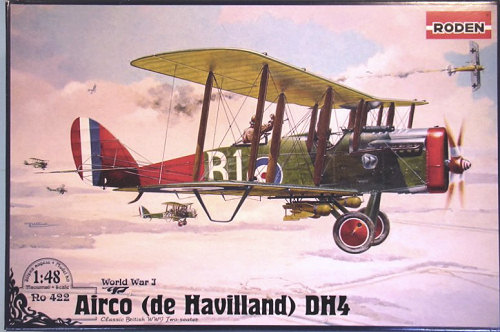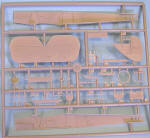
Roden 1/48 DH.4
| KIT: | Roden 1/48 DH.4 |
| KIT #: | 422 |
| PRICE: | $ 29.95 MSRP |
| DECALS: | Three options |
| REVIEWER: | Tom Cleaver |
| NOTES: | Abo |

| HISTORY |
The Airco D.H.4 was the most successful British bomber of the First World War. Designed by Geoffrey de Havilland in 1916, it was the first British two-seat day bomber to have an effective day bomber and to rely on speed for its primary defense, as its later descendant, the Mosquito, would in the Second World War. First flown in August 1916, powered by a prototype BHP engine rated at 230 hp, the BHP engine required major redesign before entering production. The first order for 50 D.H.4s, powered by the 250 hp Eagle III engine, was placed in December, 1916. As production continued, the D.H.4 was fitted with Eagle engines of increasing power, finally settling upon the 375 hp Eagle VIII, which powered most operational D.H.4s by the end of 1917. Because of chronic shortages of Rolls Royce engines in general, and Eagles in particular, alternative engines were also tried, with the BHP, the Royal Aircraft Factory RAF3A, the Siddeley Puma, and the 260 hp Fiat, all being put into production aircraft, though none of these engines was the equal of the Eagle; the problem was there were not enough Eagles available.
Armament and ordnance for the aircraft consisted of one 0.303 in Vickers machine gun for the pilot and one 0.303 in. Lewis machine gun on a Scarff ring mounting for the observer. A load of two 230 lb bombs or four 112 lb bombs could be carried. Re-engined with the Rolls-Royce Eagle, the D.H.4 entered service with the RFC and RNAS in March 1917.
The D.H.4 first entered service with the RFC in January 1917, being first issued to 55 Squadron, which commenced operations in March 1917. Two more squadrons re-equipped in May 1917. with a total of six squadrons operational on the airplane by the end of the year. The RNAS also used the D.H.4 in France, Italy, and the Aegean front.
The DH.4 was an immediate success, considered the best single-engined bomber of the Great War. Reliable and with an impressive performance even when fully loaded, the D.H.4 was popular with its crews, being easy to fly - particularly when fitted with the Roll Royce Eagle engine - while its speed and altitude performance gave it a level of invulnerability to German fighter interception, so much so that the D.H.4s often flew without fighter escort on bombing missions.
The only drawback was the distance between pilot and observer, due to the placement of the fuel tank between the crew, making communication difficult. The otherwise-inferior D.H.9 solved this by putting the pilotís cockpit where the fuel tank had been, with the tank ahead of the pilot. This was also done to American-built D.H.4s after the war.
When the United States entered the war, the U.S. Army Air Service had only 132 obsolete aircraft. The D.H.4 was selected for production as a general purpose two seater, to be powered by the Liberty engine. The D.H.4 was the only American-built airplane to see service in the First World War, with 1,213 seeing action between May 1918 and the end of the war. After the war it was the main type used by the Army Air Service and the U.S. Marine Corps between 1918-1932. The Marines pioneered dive-bombing with theirs and used them in combat in Central America in the late 1920s. D.H.4s also provided the backbone of the early U.S. Air Mail, flown by pilots like Charles A. Lindbergh.
| THE KIT |
 Aurora first produced a D.H.4 in 1/48 in 1958, which was the only kit of the
airplane in this scale until Blue Max released a Liberty-powered American D.H.4
in 2002. (Readers may recall that AMT had a 1/48 DH.4 kit that was issued in the late
1960's or early 1970's. Ed)
Aurora first produced a D.H.4 in 1/48 in 1958, which was the only kit of the
airplane in this scale until Blue Max released a Liberty-powered American D.H.4
in 2002. (Readers may recall that AMT had a 1/48 DH.4 kit that was issued in the late
1960's or early 1970's. Ed)
This new kit by Roden has been eagerly awaited by World War I modelers since it was first announced over two years ago. It is worth the wait.
The kit has admirably-thin wings and tail surfaces, with fabric detail done very
accurately as Roden has been doing the past few years. The fuselage is designed
with the upper section separate from the lower fuselage halves. This means that
the kit will be r eleased as the late versions with the differing cockpit
locations. Roden has already announced the early American D.H.4, and the early
and late D.H.9. It will not be difficult to do a D.H.4M with the late D.H.9,
and there is a possibility Roden will release a mail plane.
eleased as the late versions with the differing cockpit
locations. Roden has already announced the early American D.H.4, and the early
and late D.H.9. It will not be difficult to do a D.H.4M with the late D.H.9,
and there is a possibility Roden will release a mail plane.
The kit has excellent detail parts as one has come to expect from Roden, with beautiful machine guns and accurate bombs.
Decals are provided for two RNAS and one RFC squadron.
| CONCLUSIONS |
This is a very nice, quite accurate kit of one of the most important aircraft of the First World War and for the 14 years following, in both military and civilian versions. British World War I aircraft generally have more complicated rigging than do most German aircraft, so a modeler should have some experience in rigging biplanes in order to get maximum enjoyment from the project. Highly recommended.
Review kit courtesy of Roden.
January 2008
If you would like your product reviewed fairly and quickly, please contact me or see other details in the Note to Contributors.